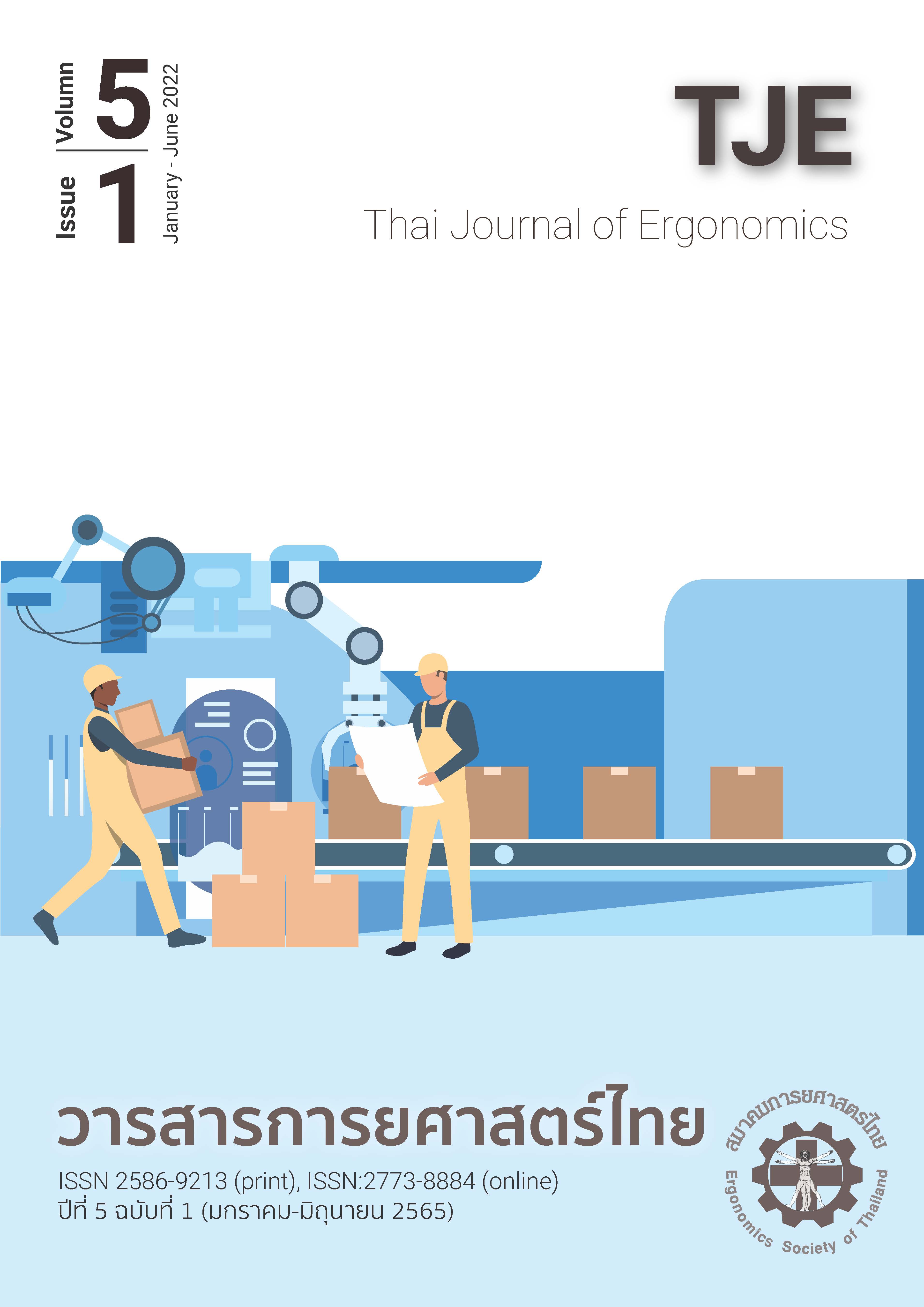การปรับปรุงสถานีงานเพื่อลดความเสี่ยงด้านการยศาสตร์ของผู้ใช้งานกล้องจุลทรรศน์
Main Article Content
บทคัดย่อ
การใช้งานกล้องจุลทรรศน์มักทำให้ผู้ใช้งานต้องทำงานอยู่ในท่าทางซ้ำๆเป็นเวลานานอาจทำให้เกิดความเมื่อยล้าและอาการผิดปกติของกล้ามเนื้อได้ การวิจัยครั้งนี้มีวัตถุประสงค์ 1) เพื่อประเมินระดับความรู้สึกเมื่อยล้าของผู้ใช้กล้องจุลทรรศน์ 2) เพื่อประเมินระดับความเสี่ยงด้านการยศาสตร์ในผู้ใช้กล้องจุลทรรศน์ 3) เพื่อปรับปรุงสถานีงานให้เหมาะสมตามหลักการยศาสตร์ กลุ่มตัวอย่างที่ในการศึกษาครั้งนี้ คือผู้ที่ใช้งานกล้องจุลทรรศน์ภายในมหาวิทยาลัยเทคโนโลยีสุรนารี จำนวน 22 คน ประเมินความเมื่อยล้าโดยใช้แบบประเมินความเมื่อยล้า (Body Discomfort) ประเมินความเสี่ยงด้านการยศาสตร์โดยเทคนิค RULA ผลการศึกษระดับความความเมื่อยล้าของผู้ใช้งานฯ พบว่า ตำแหน่งที่เมื่อยล้าสูงสุด คือ คอ ไหล่ หลังส่วนบน แขนส่วนบน ข้อศอก มือและข้อมือ ผลการประเมินความเสี่ยงด้วย RULA พบว่า Final Score อยู่ในระดับ 3 (ควรมีการศึกษาเพิ่มเติมและติดตามวัดผลอย่างต่อเนื่องอาจจะจำเป็นที่จะต้องมีการออกแบบงานใหม่) ผู้วิจัยจึงได้ปรับปรุงสถานีงานโดยออกแบบและเปลี่ยนเก้าอี้ที่ใช้ในการปฏิบัติงานเพื่อให้เกิดความเหมาะสมกับสัดส่วนร่างกายและลักษณะงาน โดยจัดให้มีพนักพิงที่รองรับกระดูกสันหลังช่วงเอว เก้าอี้ที่สามารถปรับระดับให้สูง-ต่ำได้ ปรับให้เบาะรองนั่งนุ่มขึ้น ผลการปรับปรุงพบว่าระดับความเสี่ยงด้วย RULA ลดลงอยู่ในระดับ 2 (ยอมรับได้ แต่อาจจะมีปัญหาทางการยศาสตร์ได้ถ้ามีการทำงานดังกล่าวซ้ำๆต่อเนื่องเป็นเวลานานกว่าเดิม) ส่งผลให้กลุ่มตัวอย่างมีความรู้สึกเมื่อยล้าลดลง ทำให้ผู้ใช้งานส่วนใหญ่มีความพึงพอใจต่อการปรับปรุงสถานีงานการใช้กล้องจุลทรรศน์ในระดับมาก
Article Details

This work is licensed under a Creative Commons Attribution-NonCommercial-NoDerivatives 4.0 International License.
References
Sillanplili J, Nyberg M, Laippala P. A new table for work with a microscope - A Solution to ergonomic problems. Appl Ergon. 2003;34(6):621-6.
Nupura RN, James G. Prevalence of musculoskeletal problems and awareness about ergonomics in laboratory technicians working on microscope. Int J Physiother Res 2017;5(3):2073-6.
George E. Occupational hazard for pathologists: microscope use and musculoskeletal disorders. Am J Clin Pathol. 2010;133:543–8.
Franco G. Health disorders and ergonomic concerns from the use of the microscope: A voice from the past. Am J Clin Pathol. 2011;135:170–1.
Agrawal PR, Maiya AG, Kamath V, Kamath A. Musculoskeletal disorders among medical laboratory professionals-a prevalence study. Int J Res Med Sci. 2014;2(4):1262-6.
George E. Occupational hazard for pathologists: Microscope use and musculoskeletal disorders. Am J Clin Pathol. 2010;133(4):543-8.
Thompson SK, Mason E, Dukes S. Ergonomics and cytotechnologists: Reported musculoskeletal discomfort. Diagn Cytopathol. 2003;29(6):364-7.
LaDou J, Harrison R, editors. Current occupational & environmental medicine. New York: McGraw-Hill; 2014.
Corlett EN, Bishop RP. A technique for measuring postural discomfort. Ergonomics. 1976; 9:175-82.
McAtamney L, Corlett EN. RULA: A survey method for the investigation of work-related upper limp disorder. Appl Ergon. 1993;24(3):91-9.
Anish AG, Shubhangi AM, Malik AA, Monal BY, Shweta P, Nilesh P. Ergonomic microscope: need of the hour. J Clin Diagnostic. 2015;9(5):62-5.
Kim M-S. Influence of neck pain on cervical movement in the sagittal plane during smartphone use. J Phys Ther Sci. 2015;27:15–7.
Yassierli Y, Juraida A. Effects of netbook and tablet usage postures on the development of fatigue, discomfort and pain. J Eng Technol Sci. 2016;48:243–53.
Leivseth G, Drerup B. Spinal shrinkage during work in sitting posture compared to work in a standing posture. Clin Biomech. (Bristol, Avon) 1997;12:409-18.
Darragh AR, Harrison H, Kenny S. Effect of an ergonomics intervention on workstations of microscope workers. Am J Occup Ther. 2008;62:61-9.

